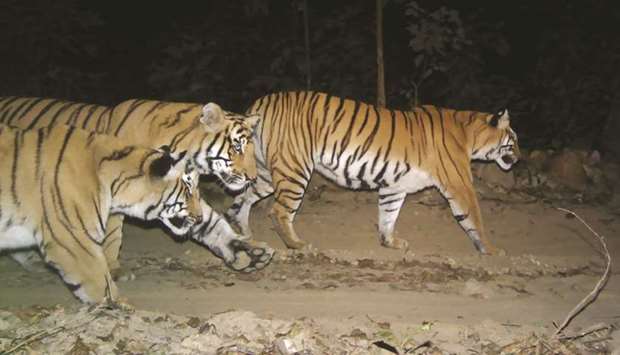Chayan Kumar Chaudhary flicked through photographs captured on a hidden camera in the jungle, hoping his favourite big cat – dubbed “selfie tiger” for its love of the limelight – had made another appearance.
Thousands of camera traps have helped conservationists track Nepal’s wild tiger population, which has nearly doubled in recent years as the big cats claw their way back from the verge of extinction.
After a nine-year push to protect tigers, an exhaustive census across 2,700km (1,700 miles) of Nepal’s lowlands completed earlier this year revealed the population has grown from 121 in 2009 to an estimated 235 adult cats today.
On the frontline of the painstaking survey were trained locals like Chaudhary in western Nepal’s Bardia National Park where tiger numbers have grown nearly fivefold.
The 25-year-old helped track and record wild tiger movements through the park by scanning images taken by cameras hidden in the jungle’s undergrowth.
“It was very exciting when we checked the (memory) cards and found photos of tigers,” Chaudhary said.
“It felt like we are part of something big.”
Nepal’s southern lowlands, home to five national parks, were mapped into grids, each fitted with a pair of camera traps to record any tiger activity.
More than 3,200 of these special camera traps were installed, some by field workers on elephants to navigate the dense jungle.
“It was not an easy process and risky as well,” said Man Bahadur Khadka, head of Nepal’s department of wildlife and national parks.
These cameras were equipped with sensors that triggered a click whenever any movement or a change in temperature was detected.
Soon the photos started to trickle in: lone tigers walking past, mothers with their playful cubs and the occasional tiger feasting on a fresh kill. And Chaudhary’s favourite: a big cat that seemed to enjoy preening in front of the lens.
The census began in November 2017 and by the following March, more than 4,000 images of tigers had been collected.
Nepal has tough punishments for poachers – up to 15 years in jail and a heavy fine – and it has recently started a genetic database of its tigers to aid investigations.

This handout photograph shows Bengal tigers in the Bardia National Park, some 500kms southwest of Nepal’s capital Kathmandu.


